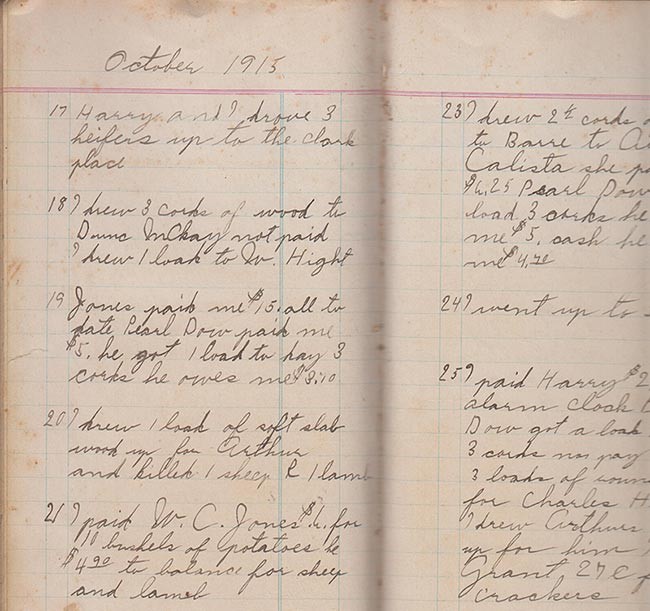A couple weeks back our friend Mike Batten, a logger who lives down the road from our office, dropped off a century-old journal he thought we might find interesting. It was kept by Ernest Magoon, a farmer and woodsman who lived in West Topsham, Vermont.
I’ll admit that I’m a sucker for historical non-fiction. Years ago I wrote several history books and during long hours in dark library basements pouring over microfilm I found myself constantly sidetracked from my research. Every page of an old newspaper seemed to hold a story that caught my attention – a local murder mystery, a bank robbery, an account of a major world event reported in real time. So I cracked open Mr. Magoon’s journal, in which he made entries almost daily from 1914 to 1917, eager for a firsthand account of rural life back then.
In that regard, the journal didn’t disappoint. Ernest captured, in great detail (and in impeccable handwriting), his day-to-day activities. How many loads of manure he hauled, how many trees he cut, when he sheared his sheep, how many pounds of milk he brought to the creamery.
April 15, 1914: I bought 60 cents worth of groceries off Grant, paid. Killed a calf. Ed helped me sack my wool 192 1/2 lbs and 18 1/2 lbs of hide.
Aug. 12, 1915: Clarence Moulton got a load of lumber – 1900 feet. Arthur, William, Harry, and I hayed; we got 5 loads.
Feb. 23, 1916: Big snow storm. I drew 1 load of logs out to mill.
Probably 80 percent of the entries include financial information. The whole thing almost reads more like a check register than a journal.
April 11, 1914: Stanley and I cut 44 trees. He went home for good. I paid him $2, I owe him $29.
Oct. 2, 1915: Harry and I went over to East Barre. W.C. Jones paid me $13.70 for 2 sheep and 2 barrels of apples. I paid $1.57 for grain. Rained most all day.
Jan. 17, 1916: I drew 1,700 lbs of hay from the Clark place to Jones, he paid me $15.50 for hay and one sheep. Lepeig had 1 load of round wood, Peo had 1 load of slab wood. Clarence Moulton stayed here.
The theme is pretty clear: he got up every morning, worked hard, and was very careful with his money.
What I couldn’t tell from the journal was anything more about Ernest Magoon. Three years of almost daily entries and I couldn’t tell you if he was married, or had kids, or friends, or had any plans for his future. The only hints of personal details I spotted came in three consecutive entries from late 1916 and early 1917.
Dec. 31: Crissie, kids, and I went up to Marms and had dinner up to the Eli Mills place.
Feb. 2: Ernest, Doris, and I was up to see Mother today. She passed away at 9:15 at night.
Feb. 5: Ernest, Doris, and I went to Mother’s funeral.
There were no days off noted, no “it was a beautiful Sunday afternoon so I went canoeing.” The closest thing to recreation or relaxation seemed to be twice-annual hunting trips. Definitely no vacations or kids’ soccer games.
In a way, the monotony was heart-warming. You hear romanticized stories about how difficult life was in earlier times, and how hard people worked just to survive. Ernest Magoon lived that life. His neighbors did, too. And in today’s age, when so many people want to immediately share every thought and feeling they have on social media, it was refreshing to find someone who didn’t feel the need to do that, even in a personal journal. There was also, as far as I could find, not a single complaint or problem recorded. Certainly during those three years, Ernest must have been injured, been disappointed by a harvest, been worried about something. But, ever the tough old Yankee, none of those things were deemed worthy of sharing, even with himself. It’s tough not to marvel at that.
But after reading the hundreds of daily reports of all the work he did, I mostly came away just hoping that Ernest also occasionally took a walk in the woods on a nice day, or had fun at a child’s birthday party, or felt some satisfaction at the end of the day – even if he didn’t record it. It also struck me that, while times are undeniably easier from a survival standpoint, our lives today can get pretty busy with work. I’m pretty sure that if I kept a journal there are weeks when it could look pretty much like Ernest Magoon’s – a checklist of jobs completed and an accounting of the bills that need to be paid. It was a reminder that, no matter how much work there is to do, it’s important to take some time to enjoy life.



Discussion *